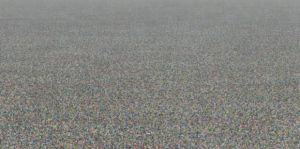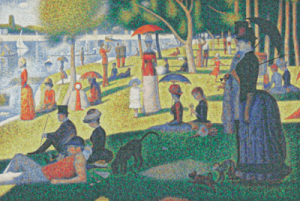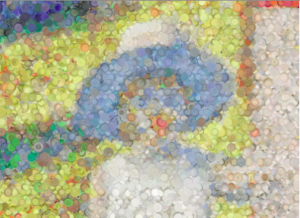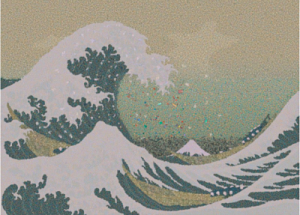By Kimberly Duncan ’18 (Charlotte, NC)
In most cases, people think plastic waste ends its journey in the trashcan. It is rare that we consider our waste’s next steps or the harm it may cause. Our society has obtained an “out of sight, out of mind” mentality about the things we throw away because we are often too involved in our own lives and problems to be concerned about a plastic bottle. That, in addition to our high consumption rates and throwaway society, poses an issue for many ecosystems. Specifically, marine ecosystems have experienced much pollution from carelessness in plastic waste disposal in quantities that are too abstract to our minds.
Artist Chris Jordan has closely observed the high rates of plastic consumption in America and the effects it has on Marine ecosystems. He addresses many issues relating to consumption that have social, economic, and environmental themes in his artwork. His focus is to take “statistics from the raw language of data, and to translate them into a more universal visual language, that can be felt” (Jordan 2008). In his series Running the Numbers and Running the Numbers II, he transforms objects that remind us of “the environmental footprints 1,000 miles away of the things that we buy [and] the social consequences 10,000 miles away of the daily decisions that we make as consumers” (Jordan 2008). In several of his pieces, he shows the egregious amounts of plastic we waste in just seconds, minutes, and hours.
Jordan’s website shows his pieces from far away and, upon clicking on the image, it zoom in to show the composition of the piece. Here are a few examples from Running the Numbers and Running the Numbers II of America’s plastic consumption.
Running The Numbers:
Plastic Bottles, 2007 (60×120″)
From far away, this image is unrecognizable. However, upon looking closer, you can see that this image “depicts two million plastic beverage bottles, the number used in the US every fifteen minutes” (Jordan 2007)
Plastic Bottles, 2007 (enlarged)
Caps Seurat, 2011 (60×90″ in one panel, and 88×132″ in 3 panels)
This image “depicts 400,000 plastic bottle caps, equal to the average number of plastic bottles consumed in the United States every minute” (Jordan 2011).
Caps Seurat, 2011 (enlarged)
Running the Numbers II:
In this series you begin to see the direct relationship between plastic waste and the rate at which it enters the ocean.
Gyre, 2009 (8×11 feet, in three vertical panels)
This “depicts 2.4 million pieces of plastic, equal to the estimated number of pounds of plastic pollution that enter the world’s oceans every hour. All of the plastic in this image was collected from the Pacific Ocean” (Jordan 2009).
Jordan is effective in creating jarring images that accurately represent the amount of plastic waste Americans create. He takes abstract statistics and shows them in a more understandable way to evoke a response in his viewers. In his series titled Midway, Jordan reveals the direct effects of this plastic waste circulating in the ocean gyres on birds. These harrowing images document the plastic from the ocean that was consumed by birds that most likely died as a result.
Chris Jordan created these images as an attempt to make Americans more concerned about improper plastic waste disposal and its effect on marine ecosystems. It pays to take a little extra time to make sure you correctly dispose of plastic waste because, even though you may not experience the effects, ecosystems are being polluted. You can start by finding recycling plants in your area and become familiar with recycling protocol for curbside pickup! For more information on the artist Chris Jordan, visit his website.
At Colgate, we recycle all plastics #1-7. For more information, read our post on the FAQs of recycling at Colgate.
References:
Jordan, Chris. (2008, February). Jordan: Turning Powerful Stats into Art. Retrieved from: https://www.ted.com/talks/chris_jordan_pictures_some_shocking_stats/transcript?language=en
All images were retrieved from Chris Jordan’s website. www.chrisjordan.com







Very nice article, Kimberly! Beautiful pictures he has created from trashed plastic.